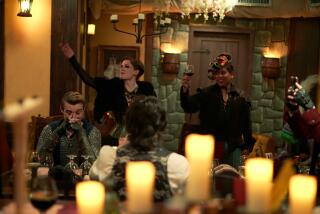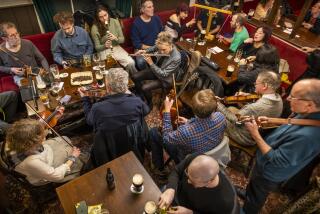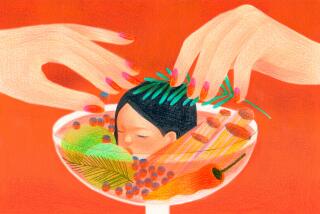Traditions Under Attack : Big Changes Brewing for British Pubs
- Share via
LONDON — The threat is to the very fabric of society, the British are warned. The mass media are up in arms, members of Parliament in revolt.
At issue is something as vital as politics or religion: that unique British institution known as the public house, or pub.
“An Englishman’s pub is his castle,” the conservative Daily Telegraph thundered. “It is one thing for the government to tangle with the bar or the doctors, but if it upsets the nation’s drinkers, its goose will be well and truly cooked.”
Drastic Changes Urged
The Telegraph referred to a new government study that urges drastic changes in the way pubs are owned and operated and, most important, seeks to limit the number of pubs owned by a single brewing firm. According to the nation’s brewers, it could result in chaos, possibly a fatal blow to the pub.
Sixty Conservative Party members of the House of Commons broke ranks and sided with the brewers.
Now the government and the brewers have agreed to sit down and talk the whole thing over. Whatever the outcome, one thing seems sure: While the pubs are in a period of extraordinary change, reports of their demise, to borrow Mark Twain’s wording, are greatly exaggerated.
“People have probably been complaining for hundreds of years that ‘pubs today aren’t what they used to be,’ ” Alisdair Aird, editor of the Consumer Association’s 1989 “Good Pub Guide,” said in an interview.
“It’s a continuing refrain, really. But while “pubs do change . . . perhaps too much can be made of the ‘demise of the great British pubs.’ ”
Many Pubs Disappeared
There were pub post-mortems during the redevelopment of British cities in the 1950s and 1960s, when thousands of drinking establishments in fact disappeared. Shifting classifications make exact comparisons difficult, but the number of pubs is believed to have increased in the last 20 years, to about 75,000.
But none of this stops Britons from lamenting an earlier lost pub era, in much the way a car buff nostalgically recalls his first used car, mechanical shortcomings and all.
Sometimes the English seem to spend more time analyzing their pubs and romanticizing over them than drinking in them.
“No other single institution has aroused so much emotion as the English pub,” according to a promotional article in a London tourist magazine. “In the thousand or so years since pubs were introduced in this country, people have talked about them, written about them, laughed in them, played in them and relied upon them for food, drink and companionship.”
The book section at Harrods department store lists 47 titles dealing with pubs, and there are at least four regular magazines on the subject. By one count, the new government report, an exhaustive study by the Monopolies and Mergers Commission, was the 16th major inquiry into pubs and other aspects of Britain’s drinking habits in the last 23 years.
The Campaign for Real Ale, which lobbies on behalf of traditional pubs and old-fashioned beer made in the basement, has been called “the most successful pressure group in Western Europe.”
This time it is the brewers who have leaped to the defense of tradition, not so much out of patriotism, one suspects, as because the Monopoly Commission’s recommendations would largely dismantle what the commission described as a monopolist, 239-year-old “tied house” system under which the brewers either own or indirectly control at least 75% of the country’s pubs.
Many drinkers hold those same brewers responsible for “tearing the heart out of a national institution” by visiting “a plague of trendy gimmicks” on their pubs in the hope of attracting a generation of younger and more affluent urban patrons.
The argument is indicative of what the market research organization Mintel recently called the greatest period of change in the post-World War II history of the pub.
There is evidence that man was brewing ale in the British isles 5,000 years ago. The Saxons are credited with the spread of the ale house as a national institution. The names of many modern pubs derive from the signs that King Richard II made mandatory for all inns in 1393. The Red Lion, from the crest of the founder of the Plantagenet dynasty, is still the most common element of the pub sign.
Britons have long been known as beer drinkers, and in contrast to their American counterparts, who drink most of their beer at home out of cans and bottles, they do 80% of their tippling in the pubs out of pint-sized glasses.
Despite the egalitarian sound of its name, the “public house” has been very much a part of the British class system. In addition to all the pubs, there are more than 34,000 members-only clubs with bar licenses. And some pubs still have separate “public bars” for working men and “saloon bars” for the upper crust.
“The Pub and the People,” a classic 1943 sociological study, described a typical working man’s pub of the time:
“The door opens with a brass latch, disclosing a worn and scrubbed wooden floor, straight bar counter brown-painted with thick yellow imitation graining on the front paneling; at its base is a scattered fringe of sawdust, spit-littered and strewn with match-ends and crumpled cigarette packets. Facing the bar, a brown-painted wooden bench runs the length of the room.”
While Spartan, according to that study, the place had a certain dignity:
“It is the only kind of public building used by large numbers of ordinary people where their thoughts and actions are not being in some way arranged for them. In other kinds of public buildings they are the audiences, watchers of political, religious, dramatic, cinematic, instructional, or athletic spectacles. But within the four walls of the pub, once a man has bought or been bought his glass of beer, he has entered an environment in which he is participator rather than spectator.”
This was a man’s world, that of a “no-nonsense boozer,” as Stephen Cox, a spokesman for the Campaign for Real Ale, described it. Patrons played dominoes, darts and cribbage. But mostly they just drank and talked.
Perhaps, said Frank Fletcher, Mintel’s research director, that kind of pub--”the pub as a place where you just go and consume alcohol--really is dead.”
Today’s pub-goer visits his “local” less frequently, does not stay as long and drinks less than his predecessor. Often he is there mainly to meet friends before heading off for somewhere else.
On the other hand, modern pubs are generally more receptive to groups of people they once shunned. Virtually all of them not only welcome women but cater to them. Many are even happy to serve coffee and soft drinks for abstainers, although, as Pub Guide editor Aird noted, “There are still many publicans--and pub customers--who reserve for the coffee machine and the teapot the same sort of look that the virile young bullock reserves for the vet’s knife.”
‘Lager Louts, Yobbos’
The Home Office said in a report issued last month that the government should encourage the consumption of low-alcohol and non-alcohol drinks in pubs in order to counter the problem of “lager louts” and “yobbos,” as drunken young hooligans are known.
The microwave oven has helped make food an increasingly important part of the pub business. This trend was accelerated last fall when licensing laws were changed to allow proprietors to stay open all day.
Most pub menus still feature such traditional and sometimes unpalatable “pub grub” as steak and kidney pie, or “bangers and mash” (sausages and mashed potatoes). But others offer a much greater and more creative variety, and some realize so much of their income from food that the government now classifies them as restaurants rather than pubs.
Brewers have spent the equivalent of nearly $10 billion in the 1980s to modernize--traditionalists would say trivialize--their pubs. Hundreds have been turned into “theme pubs”--places like the Bull, Bear & Broker, in a new office development in London’s financial district. It has a wine bar upstairs, serves baguettes and croissants in the downstairs bar and provides up-to-the-minute market information on strategically located television monitors.
In many city pubs these days one is as likely to find a “Space Invaders” video game as a dart board. About 1,500 pubs are said to have installed karaoke machines--”Japanese juke boxes” that provide background music, a microphone and a voice enhancer to encourage amateur crooners. One pub manager in Hayes runs competitions for the worst singer, and he says his twice-a-week karaoke nights have almost tripled business.
Pubs designed for younger people may have neon lights, loud music and a resident disc jockey. “The ‘birds’ (girls) are ‘bang-on’ in here,” a young male customer was heard to remark recently at one such New Wave pub in the Midlands. “That’s why I come here.”
His companion boasted, “Every weekend I’ve pulled a girl in this very place, in this very spot, actually.”
At the other extreme are pubs making such a strong pitch for family business that they feature diaper-changing rooms. One, owned by the giant Whitbread brewery, has a playroom with $1,700 worth of Lego building blocks, and another has monkey bars outside.
The Mintel survey showed that about half the patrons still describe their ideal pub in “pretty conservative, traditional, even romantic” terms--a small, cozy country inn, a Labrador retriever lying by a roaring fire, a genial, outgoing host.
On closer inspection, however, the survey shows that most of the traditionalists are among the older and less frequent pub patrons. Among younger patrons, and those who go to a pub five to seven days a week, the desire is for something a bit livelier--a “fun pub,” with loud music, “zany characters” and “a good laugh.”
‘The New and the Smart’
Organizations like the Campaign for Real Ale “prefer the old and traditional to the new and the smart,” Brewers’ Society spokesman Kenneth Dunjohn commented. “It’s unfortunate, but the majority of our customers want the new and the smart.”
In today’s more affluent, more mobile Britain, more people are apt to travel to a pub. According to Aird, “the pub as a neighborhood local is becoming slightly less important, while the pub as a place to go on a day out in your car is much more important.”
For all the talk about the traditional pub being endangered, Aird said, “this trend is helping toward the survival of the idiosyncratic local pubs that were becoming an endangered species five years ago.” Pubs are also increasingly expensive, and the Mintel survey found that this is driving a significant number of former customers away.
The “Good Pub Guide” accuses the brewers of overcharging for their increasingly popular low-alcohol brands and the soft drinks distributed by their subsidiaries.
The Monopolies Commission argued that a few brewers control the retail market through their “tied houses” to such an extent that normal competitive forces cannot function to reduce prices. It wants brewers, some of whom now own as many as 7,000 pubs, limited to no more than 2,000.
For all this turmoil, however, a visit to the pub remains Britain’s most popular leisure pursuit outside the home. And if the Mintel research is right, it will probably remain so.
“As an institution, the pub has a healthy future,” Mintel concluded. Even the “local,” which appears to be under the most pressure, has going for it such an extraordinary atmosphere of informality that many customers see it as an extension of their home, offering “an alternative to an evening in,” as the researchers put it, “rather than . . . an evening out.”
PUB SPEAK: A GLOSSARY
Local-- A neighborhood pub.
Publican--The owner or manager of a pub; also known as gov’nor.
Ale--All British beer except stout and larger.
Mild--A low-alcohol, usually dark ale.
Bitter--A pale or copper-colored ale with high hop content.
Larger--A lighter, generally lower alcohol beer more akin to American brands.
Stout--A strong, dark brown beer brewed with roasted barley.
Bubble and Squeak--Fried mixture of potatoes and cabbage.
Larger louts and yobbos--Drunken young hooligans; yob is boy spelled backward.
More to Read
Sign up for Essential California
The most important California stories and recommendations in your inbox every morning.
You may occasionally receive promotional content from the Los Angeles Times.













